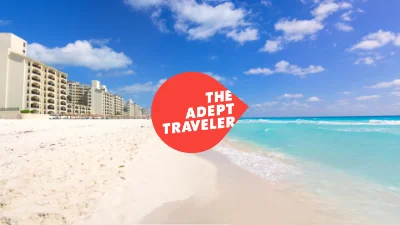Patagonia, Chile
Embark on an extraordinary journey to the ends of the Earth and experience the untamed beauty of Patagonia, Chile—a destination that promises adventure and wonder at every turn. Travel to this majestic land, where the seemingly endless skies meet jagged peaks in a dramatic dance of blues and whites, and the crisp mountain air smells of pine needles and rain. Listen to the powerful symphony of nature as glacial waters carve paths through the earth, and condors soar high above, their wings slicing silently through the wind. As you explore this rugged paradise, indulge in the flavors of locally-sourced lamb roasted to perfection, paired with the rich, earthy wines of the region. Patagonia, Chile, offers an immersive escape into wild beauty, inviting travelers to connect with nature's grandeur on every level. Prepare to be enchanted by the alluring allure of Patagonia as you dream of what lies ahead when you travel to this captivating corner of the world.
Patagonia, Chile Travel Season
Travel to Patagonia, Chile is an unforgettable journey, filled with breathtaking landscapes, thrilling outdoor activities, and unique cultural experiences. Understanding the optimal times to visit this stunning region can enhance your travel experience. The peak travel season for Patagonia is during the summer months, from December to February, when the weather is delightfully mild, and the days are long. This period is ideal for those looking to embark on extensive treks, such as the famous W Trek or the O Circuit in Torres del Paine National Park. However, this is also when Patagonia is at its busiest, with more tourists visiting the popular sites, which might lead to crowded trails and limited accommodation options.
For travelers seeking a balance between favorable weather and smaller crowds, the shoulder seasons of spring (September to November) and autumn (March to May) offer excellent opportunities. During these months, travel to Patagonia, Chile becomes especially rewarding for those who appreciate witnessing nature's transitions. In spring, wildflowers burst into bloom, painting the landscapes with vibrant colors, while autumn brings a tapestry of reds and oranges, adding a stunning backdrop to your travels. The mild weather conditions are perfect for both hiking and photography, while the reduction in tourist numbers allows for a more intimate interaction with the region's natural beauty.
Winter in Patagonia, which spans from June to August, although colder and more challenging, presents a unique travel experience for those willing to brave the conditions. The region's iconic landscapes, such as the jagged peaks and sprawling glaciers, take on a magical quality when blanketed in snow. Travelers can engage in exciting winter activities, such as skiing and snowboarding in resorts near Bariloche or venturing on ice treks across the majestic glaciers. While some hiking routes might be inaccessible, the solitude and serenity of Patagonia during the winter months provide a different perspective, perfect for adventurers seeking tranquility away from the bustling crowds.
Local Events and Festivals
When planning travel to Patagonia, Chile, it's also worthwhile to consider the local events and holidays that occur throughout the year. In February, Patagonia celebrates the Fiesta de la Cereza, or Cherry Festival, in the town of Chile Chico, with festivities including music, dancing, and local culinary delights. This event provides an insight into the agricultural heritage and vibrant culture of the region. Another significant celebration is the gaucho festival in early spring, where visitors can witness traditional Patagonian horsemanship and enjoy authentic folklore performances.
Traveling during the off-peak season can bring additional perks, such as reduced accommodation rates and the chance to explore the tranquil beauty of Patagonia without the summer crowds. Travelers can expect a more relaxed pace, allowing them to immerse themselves deeply in the breathtaking surroundings. Furthermore, engaging with the locals can be more personal and rewarding, offering an authentic glimpse into the Patagonian way of life.
The Weather and Seasons in Patagonia, Chile
Patagonia, Chile, renowned for its stunning landscapes and unique ecosystems, experiences diverse weather patterns influenced by its geographical location. Travelers considering a journey to Patagonia can anticipate distinct weather changes that vary from one season to the next. The region's weather is largely shaped by the Andes mountains and the Southern Ocean, resulting in a variety of climatic conditions.
Summer in Patagonia, Chile
During the summer months, from December to February, travelers experience the most pleasant weather in Patagonia, Chile. Temperatures generally range from 50 to 73 degrees Fahrenheit (10 to 23 degrees Celsius), making it an ideal time for outdoor activities. The weather during this period is mild and relatively dry, with the least rainfall occurring in summer. Although occasional rain showers are common, summer offers the best conditions for those planning to explore the region's trails and national parks.
Winter Travel to Patagonia
Winter in Patagonia, from June to August, presents a dramatic shift in climate. Temperatures during this season typically range from 30 to 45 degrees Fahrenheit (-1 to 7 degrees Celsius). Travelers visiting Patagonia during winter should be prepared for cold and wet conditions, as this period sees increased rainfall and even snowfall at higher altitudes. The shorter days and cooler temperatures make winter less ideal for travel to Patagonia, although it offers stunning snowy landscapes for those seeking a winter adventure.
Spring and Autumn in Patagonia
Both spring (September to November) and autumn (March to May) are shoulder seasons in Patagonia, Chile, offering a balance between the extremes of summer and winter. Spring sees moderate temperatures ranging from 40 to 61 degrees Fahrenheit (4 to 16 degrees Celsius), and is characterized by blooming flora and less crowded attractions. Autumn, with temperatures between 40 and 63 degrees Fahrenheit (4 to 17 degrees Celsius), showcases vibrant foliage, making it a picturesque time for travel. These seasons typically experience more rainfall than summer but less than winter, providing a comfortable middle ground for those planning to travel to Patagonia, Chile.
Ideal Time for Travelers
For those planning a travel itinerary, the most favorable weather conditions occur during the late spring to early autumn period (November to April). This timeframe presents the most stable weather for travel to Patagonia, offering mild temperatures and reduced chances of harsh weather disruptions. It is also the best period for engaging in outdoor activities such as trekking, kayaking, and wildlife viewing, as well as experiencing local events and festivals that often tie in with the warmer months.
Travelers should be mindful of Patagonia's unpredictable climate, where weather can change rapidly even within a single day. Packing versatile clothing and gear suitable for varying conditions is essential to ensure a comfortable and enjoyable travel experience. Regardless of the season, Patagonia, Chile offers a remarkable destination with its majestic natural beauty and dynamic weather patterns.
Accepted Payment Methods and Other Payment Information in Patagonia, Chile
Nestled at the southern end of South America, Patagonia, Chile, offers a stunning travel experience for those looking to explore its natural beauty. When traveling to Patagonia, Chile, understanding the local currency and payment options is essential for a smooth journey. The official currency here is the Chilean Peso (CLP). While it's possible to use U.S. dollars in some places, particularly in larger towns or tourist-heavy areas, paying in pesos is generally more convenient and often more cost-effective due to exchange rates.
Credit card usage is widespread in Patagonia, Chile, particularly in larger hotels, restaurants, and shops in towns such as Punta Arenas or Puerto Natales. Visa and Mastercard are the most commonly accepted credit cards, allowing travelers to make purchases with relative ease. American Express is also accepted but to a lesser extent, and Discover cards are rarely usable, so it's advisable to have another form of payment ready if needed. It's important for travelers to ensure their cards are activated for international use before travel, and also to inform their home bank of their travel plans to prevent any security holds on transactions.
Cash remains a crucial part of everyday transactions in Patagonia, especially in smaller towns or rural areas where credit card machines might not be available. ATMs are available in major hubs, allowing travelers to withdraw Chilean Pesos. However, it's good practice to carry a modest amount of cash, particularly if planning to explore remote areas or engage in activities such as local markets or small eateries where cash is often the preferred method of transaction.
Considering local customs, tipping is appreciated but not compulsory in Patagonia, Chile. It is common to leave a 10% tip at restaurants if service has been satisfactory. For tour guides and drivers, tipping is a thoughtful way to show appreciation for exceptional service, though the amount is generally left to personal discretion based on the level of service provided.
When planning your travel to Patagonia, it's wise to have a combination of payment methods, including credit cards and cash in Chilean Pesos, to ensure flexibility across different circumstances. Being prepared with varying payment options will enhance the overall travel experience, allowing for seamless purchases and interactions with locals throughout your adventure in Patagonia, Chile.
Why You Should Travel to Patagonia, Chile
Travelers seeking an adventure like no other should consider a journey to Patagonia. This extraordinary region in Chile captivates the heart and soul with its breathtaking landscapes and unique experiences. From colossal glaciers to rich culture, the promises of travel to Patagonia, Chile are unmatched.
Majestic Landscapes
The stunning and raw beauty of Patagonia, Chile, is one of the most compelling reasons to visit. Towering mountains, expansive ice fields, and endless plains define the landscape. The Torres del Paine National Park, a UNESCO biosphere reserve, offers some of the most impressive vistas on Earth. Dramatic peaks, azure lakes, and diverse wildlife create a dramatic backdrop for outdoor enthusiasts.
Challenging Trekking Routes
Travel to Patagonia for world-class trekking routes like the W Circuit and the O Circuit in Torres del Paine. These trails challenge adventurers with diverse terrains, rewarding them with views of granite cliffs, glaciers, and sprawling valleys. Hikers from around the world embark on these routes to experience the untamed wilderness firsthand.
Rich Indigenous Culture
Travel to Patagonia, Chile, also offers a cultural journey into the traditions of the indigenous Mapuche and Yaghan people. Visitors can explore museums, participate in cultural festivals, and enjoy traditional Mapuche crafts, music, and gastronomy. This cultural richness adds depth to the Patagonian experience.
Diverse Wildlife
Patagonia is a haven for wildlife lovers. The region is home to guanacos, Andean condors, pumas, and Magellanic penguins. A visit to the Tierra del Fuego or Isla Magdalena provides opportunities to see colonies of these charming penguins in their natural habitat, making travel to Patagonia a must for nature enthusiasts.
Extreme Sports and Adventure
The region's diverse topography offers ample opportunities for extreme sports, attracting travelers seeking an adrenaline rush. From kayaking among icebergs to rock climbing in the Andes, Patagonia, Chile, provides a variety of activities for thrill-seekers eager to push their limits in a pristine natural environment.
Remote Serenity
For those seeking solitude and a retreat from the hustle and bustle of city life, Patagonia offers tranquility and isolation. The vast, open spaces and soothing landscapes allow visitors to disconnect from the modern world and immerse themselves in nature's tranquility, making it an ideal destination for those looking to recharge.
Marine Attractions
Patagonia is not just about mountains; it also boasts spectacular marine attractions. Travelers can embark on cruises through the fjords or take a tour to see the famous San Rafael Glacier. Many visitors travel to Patagonia to experience the awe-inspiring sight of massive icebergs calving into the sea.
Gastronomic Delights
Patagonian cuisine is an experience in itself, characterized by fresh, locally sourced ingredients. From succulent lamb and beef to the freshest seafood, travelers to Patagonia, Chile, can savor a range of traditional dishes. The region’s wineries also offer unique southern hemisphere vintages worth exploring.
Unique Climate and Seasons
The climate in Patagonia is as diverse as its landscapes. Seasons bring distinct changes, offering unique experiences year-round. Whether it’s the spring flowers, summer's long days, autumn’s vibrant foliage, or the serene beauty of a winter landscape, each season offers something special.
A Chance to Disconnect
Patagonia offers travelers the rare chance to disconnect from the digital world. With limited connectivity in some areas, visitors can embrace and appreciate the natural world around them, indulge in pure experiences, and return from their travels with a renewed perspective.
The History of Patagonia, Chile
The vast and mesmerizing region of Patagonia, Chile, stretching from the southern tip of the Andes to the Pacific Ocean, is a land filled with historical intrigue and cultural depth. Historically, this spectacular landscape was inhabited by indigenous groups like the Tehuelche and the Mapuche, whose rich cultural traditions have left an indelible mark on the region. The arrival of European explorers in the 16th century set the stage for a transformative era, as figures such as Ferdinand Magellan traversed this remote land. The Magellan Strait, a critical navigational route named after the famed explorer, is a key historic landmark that continues to draw historians and travel enthusiasts interested in maritime exploration and the colonization of South America.
One of the most compelling reasons to travel to Patagonia, Chile, is the opportunity to explore historical sites that bear witness to its complex past. The region’s architecture carries influences from colonial times and European settlers, who established towns and settlements throughout Patagonia. Punta Arenas, the southernmost continental city in the world, boasts a fascinating blend of indigenous and European heritage. Walking through its charming streets, visitors can explore intricate mansions once home to wealthy pioneers, as well as the prominent Sara Braun Palace, a national monument. Each land plot and built environment here whispers stories of the past, drawing a vivid picture of Patagonia's development through time.
Travel to Patagonia is not just an exploration of its tactile history, but also an immersion into its cultural landscape. The blending of indigenous heritage and migrant influences is evident in traditional music, crafts, and cuisine. Visitors can attend festivals that celebrate the native heritage and partake in the art of mate drinking, a cherished communal activity. Additionally, the Patagonian landscape itself is a testament to the region's evolution through the ages. Massive glaciers, soaring peaks, and unparalleled biodiversity make the region a living museum of natural history. Stories of explorers and indigenous communities are tied to these lands, making every trek through the Torres del Paine National Park a journey into the past.
For history lovers, travel to Patagonia, Chile, offers a multidimensional experience that combines stunning natural beauty with a profound historical narrative. Whether you're tracing the paths of early explorers, appreciating the architectural heritage of its cities, or engaging with the living traditions of its people, Patagonia provides a captivating journey into the past. Its vastness and isolation have preserved numerous aspects of its history, allowing travelers to step back in time and experience a world that has long intrigued adventurers and historians alike. Patagonia, Chile, is more than just a destination; it is a gateway to understanding a unique part of world history and cultural evolution.
The Culture of Patagonia, Chile
Patagonia, Chile, a region renowned for its awe-inspiring natural landscapes, is also a captivating cultural mosaic that draws travelers from around the globe. The residents of Patagonia are a vibrant mix of indigenous peoples and descendants of European settlers, notably Welsh, Germans, and Spaniards, who have all left indelible marks on the region's cultural fabric. Local traditions are deeply rooted in the relationship with the land, influenced by the harsh but stunningly beautiful environment. These influences are seen in their sustainable practices, respect for nature, and community-centered living, making travel to Patagonia a culturally enriching experience.
Festivals in Patagonia, Chile, are a lively expression of this diverse heritage. One such event is the Festival de la Esquila in January, dedicated to shearing sheep, a key occupation in the region. This festival is not only a showcase of shearing skills but also includes traditional music, dance, and food, providing insight into the practical and celebratory aspects of Patagonian life. There are also celebrations in honor of local saints, as well as cultural festivals like the Día del Roto Chileno, which honor local customs and community stories. Travelers attending these festivals are treated to a vibrant explosion of culture, full of passion and authenticity.
Day-to-day customs in Patagonia reflect a balance between traditional practices and modern living. The people of this region maintain their connection to indigenous cultural principles such as reciprocity and communal support. Local markets, where one can find handmade crafts and traditional products, are central to social life, illustrating the timeless art forms that thrive in this part of the world. Music and dance play a crucial role, with styles that range from indigenous tunes and contemporary Chilean rhythms to the harmonies brought by European settlers. Such cultural expressions are compelling invitations for anyone looking to experience the rich tapestry of human creativity and resilience firsthand by traveling to Patagonia, Chile.
Indigenous culture in Patagonia, Chile, is increasingly acknowledged, with ongoing efforts dedicated to cultural preservation. The Mapuche people, one of the primary indigenous groups in the area, are recognized for their significant influence on regional culture, language, and art. Initiatives aimed at preserving Mapuche traditions, language education, and cultural workshops are flourishing, ensuring the survival of their rich cultural heritage. For travelers, these efforts offer a unique opportunity to engage with the living history of Patagonia, providing a deeper understanding of the region's diverse lineage. Visiting Patagonia promises a journey through time, where the past meets the present in the most enchanting ways.
The Culinary Experience of Patagonia, Chile
Exploring the culinary landscape of Patagonia, Chile, is an adventure as vast and diverse as the region's breathtaking landscapes. Those who travel to this enchanting part of the world can expect not just awe-inspiring views but also a rich tapestry of flavors deeply rooted in the area's culture and history. Patagonia proudly showcases its gastronomic offerings, which include hearty, rustic dishes made from locally sourced ingredients like lamb, fish, and berries, embodying the traditional soul of the land. The prevalence of these ingredients is no coincidence, as they reflect the rich resources available in this remote part of the world and the lifestyle of its people. Whether travelers are dining in cozy, rustic lodges or sampling street food with the locals, the culinary experience in Patagonia, Chile, is one of authenticity and warmth.
When it comes to must-try dishes in Patagonia, Chile, travelers should not miss the opportunity to taste "asado de cordero," a traditional Patagonian lamb barbecue known for its rich, smoky flavors. The lamb is typically slow-cooked over an open fire, seasoned simply with salt, allowing the natural tastes to shine. Another popular dish is "curanto," a hearty stew of meat, seafood, and vegetables, cooked using hot stones in a pit covered with leaves. This communal meal reflects the region's cultural emphasis on family and community. For those seeking a unique beverage experience, Patagonia, Chile offers a selection of wines and spirits. Local vineyards produce remarkable cool-climate wines, and no visit would be complete without tasting pisco, a South American grape brandy that Chileans cherish.
Travel to Patagonia presents a unique dining spectrum, from bustling food markets to upscale fine dining spots. In towns like Punta Arenas, Mercado Municipal is a must-visit for travelers wanting to explore local food culture. Here, vendors offer a chance to taste fresh sea urchin, king crab, and smoked salmon straight from the source. Alternatively, epicures with a penchant for fine dining can visit high-end establishments that blend local ingredients with international culinary techniques, creating innovative dishes that tell a story about the region's cultural fusion. Street food, such as empanadas with fillings of fresh seafood or locally sourced beef, offer quick and delicious options for those exploring the region on the go.
The culinary traditions in Patagonia, Chile, are not only about taste but reflect the region's rich cultural tapestry and adaptation to its harsh, beautiful natural environment. Food festivals and local markets further enrich this travel experience, offering seasonal specialties such as the indigenous calafate berry, believed to ensure those who eat it return to Patagonia. Vegetarian travelers will also find substantial options, such as dishes featuring native quinoa or stews enriched with locally grown vegetables, ensuring dietary preferences are well-catered for amidst this carnivorous culture. While Patagonia is famed for its wild nature, the culinary experience provides travelers an intimate glimpse into the daily lives and rich history of its inhabitants.
What to See and Do in Patagonia, Chile
Travel to Patagonia, Chile, reveals a landscape of breathtaking beauty and vast wilderness. Nestled at the southern end of South America, this remote region offers diverse attractions that captivate travelers of all kinds, from families to adventure seekers. As you embark on your adventure to this stunning part of the world, be sure to immerse yourself in these unforgettable experiences.
Adventuring in Torres del Paine National Park
One of the crown jewels of travel to Patagonia is Torres del Paine National Park, renowned for its towering peaks, azure lakes, and sprawling glaciers. Adventure seekers can embark on the famous "W" trek or the more challenging "O" circuit, which take you through breathtaking landscapes filled with diverse wildlife. Families can enjoy shorter hikes and scenic viewpoints, perfect for picnics and enjoying the breathtaking vistas. The park’s grandeur is unparalleled, making it a must-visit for anyone traveling to Patagonia, Chile.
Exploring the Marble Caves of Lake General Carrera
The Marble Caves, located on Lake General Carrera, offer a mesmerizing spectacle for travelers seeking natural wonders. These stunning formations have been carved over millennia by water, creating swirling patterns in the cave walls. A boat tour or a kayaking adventure allows visitors to explore these blue marvels up close, revealing their ethereal beauty as the sunlight dances on the mineral-rich waters. This hidden gem provides a tranquil escape for solo travelers and nature enthusiasts alike.
Experiencing the Espíritu of Patagonia in Puerto Natales
Puerto Natales is more than just a gateway to Torres del Paine; it’s a charming town that embodies the Espírito of Patagonia. Walk along its scenic waterfront, surrounded by snow-capped peaks and shimmering waters, or delve into its history at the Municipal Historical Museum. Families will enjoy stories of exploration and indigenous culture, while the vibrant local cuisine, featuring fresh seafood and Patagonian lamb, will satisfy all taste buds. This cultural experience enriches your understanding of life at the end of the world.
Wildlife Watching at the Penguins of Isla Magdalena
For wildlife enthusiasts, a visit to Isla Magdalena offers a unique chance to see a bustling penguin colony in their natural habitat. The island is home to thousands of Magellanic penguins, and guided boat tours offer intimate encounters with these charming creatures. The journey is perfect for families and children, providing an educational experience and an opportunity to marvel at the playful antics of penguins. Don’t forget your camera to capture these unforgettable moments of travel in Patagonia.
A Scenic Patagonian Fjords Cruise
Embarking on a cruise through the Patagonian Fjords is a breathtaking way to witness the region’s dramatic landscapes. These cruises take you through narrow waterways bordered by steep cliffs, with the chance to see glaciers cascading into the sea. Solo travelers and couples alike will appreciate the tranquility and stunning scenery, with potential sightings of dolphins, sea lions, and even whales in these rich marine environments. It’s a remarkable journey through some of Chile’s most untouched natural beauty.
Immersing in Traditional Chilean Culture at Estancias
For a unique cultural experience, spend a day or two at an estancia (a traditional Patagonian ranch). These remote cattle and sheep farms welcome visitors to experience the gaucho lifestyle. Participate in sheep-shearing, horseback riding, and even traditional asado (barbecue), making for a fantastic family travel destination. Engaging with local hosts provides insights into the rugged lifestyle of these ranches and the traditional values that have shaped Patagonian culture for generations.
Navigating the Futaleufú River's Rapids
Thrill-seekers won't want to miss the opportunity to raft the Futaleufú River, famous for its turquoise waters and heart-pounding rapids. Known as one of the premier white-water destinations in the world, the river offers a range of rapids suitable for both beginners and experienced rafters. Safety-focused tours ensure all travelers can experience the exhilaration of navigating this wild river amidst the breathtaking backdrop of Patagonia's verdant forests and steep mountains.
Photography Adventure on the Carretera Austral
The Carretera Austral is an epic road trip that showcases the diverse landscapes of Patagonia. This iconic route, offering panoramic vistas of glaciers, emerald forests, and secluded lakes, is a photographer's dream. Family travelers, as well as solo explorers, will find numerous opportunities to stop, explore trails, and capture the area's rugged beauty. The journey also allows for interactions with small, dispersed communities along the way, opening windows into the daily lives and cultures of Patagonia, Chile.
Unwinding in the Town of Coyhaique
Coyhaique, a hidden gem amidst the wilderness of Patagonia, offers a quaint retreat with the comfort of a larger town. Its backdrop of jagged peaks provides a stunning setting for relaxation. Visitors can engage with local craftspeople at the artisan market or savor authentic Patagonian cuisine in its charming eateries. Perfect for those seeking a combination of scenic beauty and cultural immersion, this town also offers access to outdoor adventures for every traveler.
Discovering the Southern Ice Fields by Sightseeing Flight
For a unique aerial perspective of Patagonia’s grandeur, consider a sightseeing flight over the Southern Ice Fields. This sprawling expanse of ice offers a dramatic, otherworldly landscape that can best be appreciated from above. Ideal for travelers short on time or seeking luxury experiences, these flights offer sights of ice flows, jagged peaks, and glacial rivers, providing an unforgettable viewing experience of one of Chile’s most impressive natural phenomena.
Traveling to Patagonia, Chile inspires awe and exploration at every turn, offering natural marvels and cultural treasures that cater to all kinds of travelers. Its diverse offerings guarantee that every journey through this remote region will be as unique as it is memorable.
Tips & Tricks for Traveling in Patagonia, Chile
Mastering Local Transportation in Patagonia, Chile
Travel to Patagonia, Chile, offers breathtaking landscapes but also logistical challenges due to its vastness and rugged terrain. Public transportation is limited, so renting a car is advisable for flexibility and convenience. Ensure your rental is a 4x4, as many roads are unpaved and can be difficult to navigate, especially in tumultuous weather. For those relying on buses, book tickets in advance during peak seasons. Familiarize yourself with the local bus schedules and be prepared for long travel times between points of interest. Hitchhiking is commonly practiced and safe, especially along the Carretera Austral, but always exercise caution and trust your instincts.
Optimizing Your Budget
Patagonia is known for its pristine beauty, not its affordability. Plan for higher-than-expected expenses, especially for food and lodging. Opt for local accommodations like hostels or family-run guesthouses, which offer not only cost savings but also opportunities to engage with locals. Grocery stores provide a budget-friendly alternative to dining out, allowing you to stock up on snacks and essentials for hiking trips. Remember that entrance fees to national parks can add up, so plan accordingly. Consider visiting during the shoulder seasons of spring and fall, when prices are lower and crowds are thinner.
Avoiding Crowds in Patagonia’s Must-See Destinations
To enhance your travel experience in Patagonia, Chile, start your days early, particularly when visiting popular spots like Torres del Paine and the Perito Moreno Glacier. Beat the crowds by exploring these iconic locations at sunrise, when you can enjoy stunning views in relative solitude. Additionally, consider aiming for lesser-known trails and attractions; Patagonia’s beauty is not limited to its famous sites. Venturing off the beaten path allows for a more intimate connection with the region's natural splendor.
Embracing Local Customs and Traditions
Understanding and respecting local customs enhances your travel experience in Patagonia, Chile. The people here take pride in their cultural heritage, often characterized by a strong connection to the land and traditional practices. Participate in local festivals or visit small towns where you can engage with artisans and understand the unique crafts and lifestyles of the region. Politeness and a few words of Spanish go a long way in building rapport. Embrace the slower pace of life and the warmth of Patagonian hospitality.
Essential Packing Tips for Patagonia’s Climate
The weather in Patagonia can be unpredictable, making it essential to pack appropriately. Layers are key, as temperatures can shift dramatically throughout the day. Ensure that your travel gear includes a waterproof jacket, thermal clothing, and sturdy hiking boots. Don’t forget a good quality hat and gloves, as well as sunglasses to deflect the powerful glare off the snow and ice. Investing in a solid, comfortable backpack will aid adventurers traveling to Patagonia’s remote areas.
Planning the Ultimate Hiking Experience
Patagonia, Chile, is a hiker’s paradise. However, unpredictability is a given, and planning is crucial to a successful hiking trip. Always check weather conditions before setting out, and notify someone of your plans if you're hiking solo. Many trails, especially in Torres del Paine, require reservations, so book ahead to secure your spot. Carry a comprehensive map, adequate water supply, and a first-aid kit. Remember that cell service can be spotty or non-existent, so plan to be offline for periods. On long hikes, pacing yourself is vital — stop, breathe, and soak in the awe-inspiring surroundings.
Finding the Perfect Spot for Photography
Travel to Patagonia, Chile, beckons photographers with its dramatic landscapes, making it a prime destination to capture stunning imagery. The “golden hour” just after sunrise or before sunset provides optimal lighting conditions. Take advantage of the contrasting colors of lenga forests in autumn or the pristine whites of the Southern Ice Fields. For unique shots, place elements like reflections on lakes or wildlife into your compositions to add depth and interest. Patience pays off; wildlife like guanacos, foxes, and the elusive puma can be captured if you’re observant and quiet.
Navigating the Language Barrier
While many in the tourism industry speak English, familiarity with basic Spanish will undoubtedly enhance travel to Patagonia. Learn essential phrases and numbers, which will assist in more rural areas where English speakers are scarce. This effort is appreciated and can lead to more genuine interactions with the locals, who are often eager to share stories and tips about their region. A small Spanish phrasebook or app can be an invaluable tool on your journey.
Choosing Between Guided Tours and Independent Exploration
Your approach to travel in Patagonia, Chile, will significantly influence your experience. Guided tours offer structured itineraries and eliminate logistical concerns, making them ideal for travelers seeking convenience. These tours often provide deeper insights into the area’s ecology and history. Conversely, independent exploration affords spontaneity and a tailored pace, preferred by those who crave solitude and the freedom to improvise their travel plans. Whichever you choose, research the most suitable options aligning with your interests and time frame.
Staying Safe in Patagonia’s Wilderness
Safety is paramount while exploring the expansive wilderness of Patagonia. Always travel with a partner when possible, especially on challenging hikes. Stay on marked trails to prevent getting lost, and pack essential safety gear such as a whistle, compass, and GPS device. Wildlife encounters are thrilling but keep a safe distance, and secure food items to avoid attracting animals. Monitor your physical condition and know your limits to ensure that your travel to Patagonia, Chile, remains an unforgettable and safe adventure.
What To Know Before You Go to Patagonia, Chile
When planning your travel to Patagonia, Chile, understanding entry requirements is essential for a smooth journey. Tourists from many countries, including the United States, Canada, and most European nations, do not require a visa for stays up to 90 days. Ensure your passport is valid for at least six months beyond your intended departure date from Chile, and check for any updates on visa regulations before you travel to Patagonia.
Health Precautions and Vaccinations
While there are no mandatory vaccinations required for travel to Patagonia, Chile, it's wise to be up-to-date on routine vaccines like measles, mumps, rubella, and tetanus. Hepatitis A and typhoid vaccinations are recommended as these can be contracted through contaminated food or water. Consider travel insurance that covers medical evacuation and emergencies, as healthcare facilities might be limited in remote areas of Patagonia.
Local Customs and Etiquette
Understanding local customs enhances your travel to Patagonia experience. Chileans are generally warm and polite; a simple “hola” (hello) or “buenos días” (good morning) goes a long way. It's common to greet with a light handshake or a cheek kiss among friends. Punctuality is valued, especially for organized tours or meetings.
Transportation Options
Patagonia, Chile, is vast, so plan your travel logistics carefully. The region is serviced by several airports, with major gateways in Punta Arenas and Puerto Natales. Local buses are a budget-friendly option for getting around, while car rentals offer flexibility for exploring remote areas. Do note that driving conditions can vary significantly, with gravel roads being common outside main thoroughfares.
Tipping Culture
Tipping is a customary practice in Chile, including in Patagonia. In restaurants, a tip of around 10% is appreciated, and it’s typically not included in the bill. For hotel staff, a small tip for services such as carrying luggage is customary. If you hire a guide for excursions into the breathtaking backdrops of Patagonia, consider tipping generously if their service enhances your experience.
Common Phrases for Travelers
While many in the tourism industry speak English, learning a few common Spanish phrases can greatly enrich your travel to Patagonia, Chile. Useful phrases include “¿Habla inglés?” (Do you speak English?), “Gracias” (Thank you), and “Por favor” (Please). Not only do these phrases help in communication but they also show respect for the local culture.
Communication Tips
For non-native speakers, a language app can be a helpful tool during your travels in Patagonia. Practice basic Spanish before your trip to build confidence. Locals appreciate the effort and it often leads to richer interactions. Remember that mobile coverage can be erratic, so downloading offline maps and language resources in advance is prudent.
Your travel to Patagonia, Chile, promises an unforgettable adventure, with its dramatic landscapes and rich cultural heritage. Being well-prepared with knowledge of local customs, health precautions, and basic communication can enhance your overall travel experience.
Accessibility in Patagonia, Chile
Travel to Patagonia, Chile presents a unique experience for nature lovers, adventurers, and those seeking unforgettable landscapes. When considering travel to Patagonia, accessibility is an essential aspect for travelers with diverse needs. Although the rugged terrain of this vast region poses challenges, there are ongoing efforts to improve accessibility for those with limited mobility, vision, or auditory needs.
Physical Accessibility in Patagonia
Travel to Patagonia, Chile, for individuals with limited mobility or those using wheelchairs, may require some additional planning. The region's natural beauty often means remote and uneven terrains. However, certain areas and attractions within Patagonia have been made more accessible due to thoughtful developments. For example, Torres del Paine National Park, a major highlight of any travel itinerary to Patagonia, offers some accessible trails. These trails are designed with smoother surfaces and appropriate gradients, allowing individuals using wheelchairs or those with mobility challenges to experience its majestic landscapes.
Accommodation Options in Patagonia
Choosing accommodations in Patagonia, Chile that cater to accessibility needs can enhance the travel experience. Many hotels and lodges in popular areas like Puerto Natales and Punta Arenas are gradually incorporating features that cater to travelers with physical disabilities. This includes wheelchair-accessible rooms, elevators, and grab bars in bathrooms. It's advisable for travelers to communicate with accommodation providers directly to ensure their specific needs are understood and catered to effectively.
Accessibility Features for Vision and Hearing Impairments
While physical accessibility sees more advancements, provisions for those with visual and auditory impairments are growing as well in Patagonia. Visitor centers within national parks and at key tourist attractions often provide information in Braille or offer audio guides, although these services are not yet standard across all locations. It's worth contacting specific sites ahead of a visit to inquire about available facilities, ensuring a smoother travel experience to Patagonia, Chile.
Public Transportation in Patagonia
Public transportation in Patagonia can be limited, given the vast distances and remote locations. However, in larger cities such as Punta Arenas or Puerto Montt, travelers can find wheelchair-accessible buses. These services may not run frequently, so planning is crucial. Renting a vehicle with modifications for wheelchair accessibility can be a suitable alternative, providing more flexibility to travel across Patagonia's scenic routes.
Accessible Tourist Attractions
Several tourist attractions in Patagonia, Chile, prioritize accessibility for travelers. Apart from Torres del Paine National Park, the city of Punta Arenas offers relatively flat streets that are easier to navigate. The Magellanic Penguins’ Natural Monument on Magdalena Island is another accessible attraction, with paths and viewing areas specifically designed to accommodate those with mobility issues. These efforts make travel to Patagonia more inclusive for everyone.
Increasing awareness and infrastructural improvements are making travel to Patagonia more accessible than before. With the careful selection of suitable accommodations, informed communication, and strategic planning, this breathtaking region can be enjoyed by travelers regardless of their mobility, vision, or auditory capabilities.
Health & Safety in Patagonia, Chile
When planning to travel to Patagonia, Chile, it's essential to be informed about various safety concerns that might affect your journey. While Patagonia is renowned for its stunning landscapes and outdoor adventures, certain precautions should be taken to ensure a safe and enjoyable trip.
Water Safety in Patagonia
Travel to Patagonia, Chile, often involves exploring remote natural areas, which may have limited access to clean drinking water. It's crucial for travelers to be aware of this and take necessary measures to ensure water safety. It is advisable to bring a reliable water purification method, such as iodine tablets, a life straw, or a portable filtration system, as untreated natural water sources may contain harmful bacteria or parasites.
Natural Disaster Risks in Patagonia
Patagonia is located in a seismically active region, which may pose earthquake risks. Travelers should familiarize themselves with earthquake safety procedures and pay attention to any local seismic activity alerts. Additionally, Patagonia's unpredictable weather can lead to harsh and rapidly changing conditions, especially in mountainous areas. When hiking or exploring, pack appropriate gear and always check weather forecasts before setting out.
Crime in Patagonia, Chile
Crime rates in Patagonia, Chile, are relatively low, but travelers should still take standard safety precautions. Pickpocketing or petty theft can occur, particularly in crowded areas or public transportation hubs. To minimize risk, keep valuables secure, be cautious in crowded places, and avoid displaying expensive items. It is also advisable to use hotel safes for storing passports and important documents.
Political and Social Climate
While Patagonia is generally a peaceful region, travelers should stay informed about the political and social situation in Chile, as occasional protests or demonstrations can occur. Checking local news and government advisories before and during your trip is a good practice to ensure you avoid any unexpected disruptions.
Health and Safety Precautions
Travelers to Patagonia, Chile, should ensure they have comprehensive travel insurance that covers medical emergencies. Healthcare facilities in remote areas might be limited, requiring travel to larger towns for significant medical needs. No specific vaccinations are mandatory for travel to Patagonia, though it is recommended to be up-to-date with routine vaccinations such as tetanus and hepatitis. Always travel with a basic first aid kit and any necessary personal medications.
Other Places You Might Like
Tierra del Fuego, Argentina - Nestled at the southernmost tip of South America, Tierra del Fuego offers a dramatic landscape of snow-covered mountains and glistening waterways similar to the breathtaking scenery found in Patagonia, Chile. Travelers who cherish the expansive, untouched wilderness of Patagonia will find delight in Tierra del Fuego's expansive national parks, pristine forests, and wildlife, including penguins and sea birds. The striking backdrop of the Beagle Channel and the sharp peaks surrounding Ushuaia, the world's southernmost city, provide an adventurous allure for anyone who has traveled to Patagonia.
Torres del Paine National Park, Chile - A short journey north from the traditional routes in Patagonia, this park is a marvel of natural beauty, with its signature Patagonian granite spires that tower over turquoise lakes. The park's diverse ecosystems are reminiscent of those found in Patagonia, Chile, offering travelers the opportunity to witness glaciers, rivers, and abundant wildlife, such as guanacos and Andean condors. Hiking enthusiasts will appreciate the challenging treks and the panoramic vistas that rival Patagonia’s grandeur, encouraging travelers drawn to Patagonia to explore its trails.
Aysen Region, Chile - Often referred to as 'The Gateway to Patagonia,' Aysen offers an increasingly popular path for travelers looking to explore the lesser-known parts of Chilean Patagonia. With its winding fjords, remote lakes, and endless forests, the Aysen Region captivates the adventurous spirit with opportunities for fly fishing, kayaking, and hiking. The lush, untouched landscapes are reminiscent of those in Patagonia, providing a serene escape that promises solitude and immersion in nature.
Fiordland National Park, New Zealand - This New Zealand wonderland captures the essence of Patagonia’s rugged wilderness through its dramatic mountains, deep fjords, and dense rainforests. Fiordland entices travelers who love Patagonia with its vast ecosystem and incredible biodiversity. Experiences such as cruising through Milford Sound or hiking the renowned Milford Track offer a parallel experience to Patagonia's renowned trekking routes, providing an unforgettable journey within the picturesque landscapes akin to those of Patagonia, Chile.
Jasper National Park, Canada - For those who have enjoyed travel to Patagonia, this Canadian park provides a spectacular contrast of glacier-fed lakes, towering peaks, and sprawling woodlands. The diverse wildlife, including elk and grizzly bears, offers similar wildlife viewing opportunities to what travelers may have experienced in Patagonia, Chile. The option for adventurous outdoor activities such as skiing on the Columbia Icefield or hiking along the stunning Valley of the Five Lakes Trail echoes the exhilarating escapades found throughout Patagonia's wild terrains.
Lofoten Islands, Norway - Known for its dramatic peaks and alluring fjords, the Lofoten Islands offer a visual grandeur akin to the landscapes of Patagonia, Chile. Travelers seeking an exhilarating blend of sea and mountain landscapes will appreciate the archipelago's distinctive topography. Activities such as kayaking through crystal-clear waters, hiking to panoramic viewpoints, and experiencing the Midnight Sun evoke the exploratory spirit cherished by those who love traveling to Patagonia.
Final Thoughts
Embarking on a travel journey to Patagonia, Chile, is akin to stepping into a land where nature exists at its most primal and majestic. This region is not just a destination; it is an experience that stirs the soul with its awe-inspiring landscapes, blending the drama of untamed wilderness with serene tranquility. Imagine exploring vast glaciers, wandering through untouched forests, and beholding the majestic Andes as a backdrop to your adventures. Patagonia offers travelers a unique connection to the natural world that is increasingly rare and incredibly valuable.
When you travel to Patagonia, Chile, you venture into a realm that attracts thrill-seekers and nature lovers alike. The region’s unparalleled trails, like those found in Torres del Paine National Park, invite you to trek across breathtaking terrains, rewarding each step with views that defy description. The vibrant cultures of the local communities offer a warm welcome and enrich your travel with their stories, flavors, and traditions, adding depth to the stunning natural beauty around you.
Choosing to travel to Patagonia means embracing an unforgettable adventure. Whether you're navigating the wild fjords, kayaking in pristine waters, or simply absorbing the peace of the Patagonian steppe under a starlit sky, each moment becomes a cherished memory. Patagonia, Chile, with its remarkable blend of natural splendor and cultural richness, stands as a definitive travel choice for those eager to experience the extraordinary. Let the call of Patagonia inspire your next great journey and discover a world that forever leaves you changed.
Las Torres Patagonia

MSC Magnifica World Cruise 2028 Booking Details

Bolivia Visa Free Entry For US And Israeli Tourists

Hotel Delay In Puerto Williams Hits Antarctica Fly Cruises
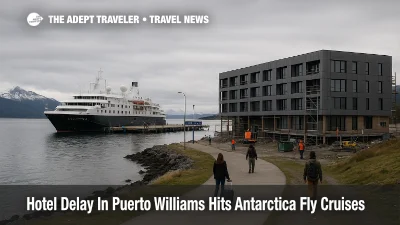
2028 World Cruise From Miami To Athens With Azamara

Chapelco Airport Closures Disrupt Early December Flights

Patagonia Blizzard Hits Torres del Paine O Circuit
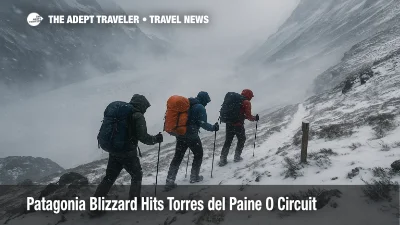
World Cruise Dubai To Barcelona 2029 Route Announced

Peru Chile Border Closure Disrupts Arica Tacna Buses

Chapelco Airport Closures Hit Patagonia Nov 25 to Dec 4

Chile Pilots Strike Disrupts LATAM South America Flights
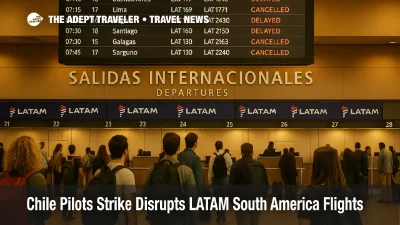
Delta Locals Trip Planner Launches With Local Guides

Chile LATAM Pilot Strike Ends, Delays To November 25

REI Teams With Intrepid For Member Adventure Trips

LATAM Pilot Strike Extends Cancellations To November 20

HX Expeditions Details 2027-28 Mindful Travel Season
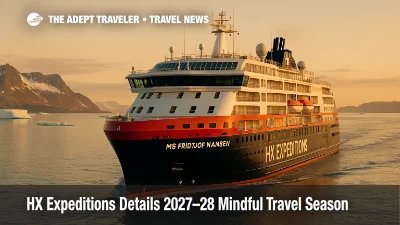
LATAM Chile Pilots OK Strike, Mediation Clock Ticks

Las Torres Patagonia reopens with renovated rooms, premium camping, and trailhead access
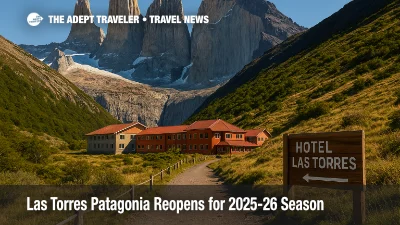
Carnival Firenze 2027 cruises: South America to Miami

G Adventures 18-to-Thirtysomethings Adds 38 New Trips
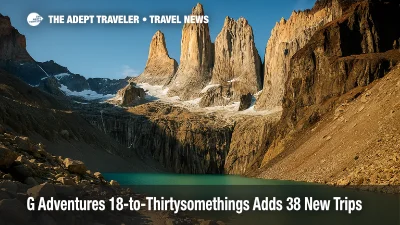
Silversea's Cormorant at 55 South to Ease Antarctica Trips
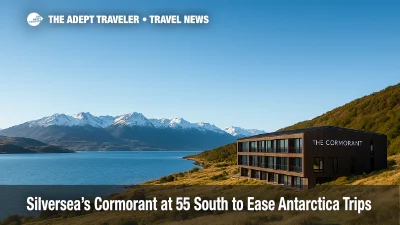
Essential Power Converters for American Travelers to Mexico & South America
